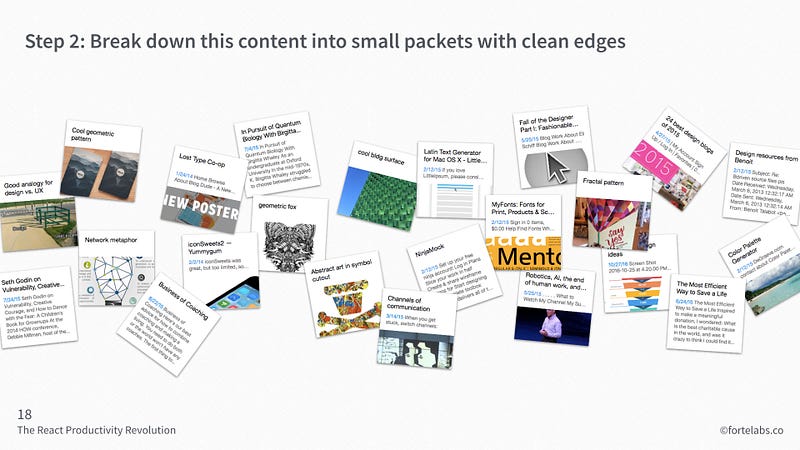Someone once asked me a question: what would it take to multiply someone’s productivity by 100?
It’s a more interesting question than the typical headlines you see online (3 Weird Tricks to 10x your Productivity!!!), because it’s so clearly out of reach using conventional approaches.
No amount of planning, effort, or hours worked will even make a dent. 100x is not an approachable number for the lone genius savant, the 100-hour-per-week-warrior, the hyper-mindful guru, or any other stereotype of superior productivity.
And yet there are precedents.
For example, Elon Musk. The level of performance at which he operates — not in checking boxes but in consistently delivering breakthrough outcomes — calls into question our assumptions about what humans are capable of.
A second example is the famous Toyota Production System (TPS). Over the course of decades they dramatically improved their throughput, boosting inventory turnover roughly 1.5 orders of magnitude while reducing defects about 4 orders of magnitude. In the process they transformed themselves from a bicycle shop that also made cars to the largest automaker in the world.
A third example is the deployment of broadband internet. I still remember the ads that came out in the late 1990s advertising “100 times the speed of dial-up.” The rapid rollout of DSL and cable connections completely transformed not just connection speeds but our entire experience of using the internet.
What all three of these examples have in common is that they leverage networks.
Elon doesn’t lock himself away to work through problems in isolation, even with his considerable intellect. He embeds himself in multiple company networks, where information can flow through him and around him at maximum speed and density. He links these companies together to form an even bigger network, applying lessons learned in one business to another.
The Toyota Production System first emerged in response to a problem unique to the small Japanese auto market: low volumes that made it impossible to dedicate entire lines to a single design. Unlike Ford with unlimited demand for its black Model-T, Toyota was forced to split production lines between multiple models. This forced them to create production networks, with complex pathways diverging and converging between machines based on the orders received each day. Many of the elements of the TPS toolkit can be thought of as tools and practices for managing and improving these networks.
Broadband internet spread around the world like wildfire due to a crucial implementation detail: it piggybacked on existing telephone and cable networks. It’s really pretty remarkable: the same twisted pair copper wiring using technology invented by Alexander Graham Bell in 1881 is today used to carry signals he never could have dreamed of. Instead of spending decades digging trenches, laying cable, and running new lines, we took advantage of unused bandwidth and new technologies to make the switch almost overnight.
This third example, I believe, is both the least examined, and the most promising when it comes to understanding the power of networks.
With traditional telephone connections, the bandwidth needed for the call is dedicated to the call for its full duration (called circuit switching). Even in complete silence, when neither person is talking, the full bandwidth is reserved and cannot be used for anything else. This is analogous to reserving a whole lane of the freeway from San Francisco to Los Angeles, for the full duration of your car ride.
Broadband internet required numerous inventions, but one of the most important was packet switching. Instead of sending the data through one channel, one bit at a time, in the right order, packet switching networks break up the data stream into little “packets.” These packets are individually labeled and tracked by routers and switches, which send them along multiple pathways through the network and then reassemble them at the other end. This is analogous to a car using up only the space it actually needs at any given time, and leaving the lane behind it and in front of it for other cars to use.
Packet switching has numerous benefits, many of which we recognize as features of the internet itself:
- packets can be routed through multiple pathways, making connections faster and more resilient to disruption
- packets can arrive in any order, so the pathways used can be of different speeds
- bandwidth can be allocated dynamically, as needed, freeing up unused bandwidth for other connections that need it
- packets can be multiplexed (compressed and interleaved), increasing available bandwidth and allowing multiple signals to be transferred simultaneously
- packets can be buffered, queued, and forwarded with variable speeds, reacting to link capacity and traffic load on the network
- different forwarding rules can be used, to favor certain connections or kinds of traffic
- packets can be tracked and sent again if they get dropped or corrupted
In addition to the speed and resilience packet switching provides, and most importantly for our purposes, it also massively increases the throughput of information that can be transferred through a network.
Why is that?
It is because there is no single bottleneck or central hub through which all traffic has to flow. There is no single point of failure where a traffic jam can bring everything to a halt. Such a network starts to benefit from network effects: every additional node in the network improves the connections of all the other nodes, in a self-perpetuating cycle that can grow explosively.
Just as packet switching transformed the throughput of telecommunications networks, I think we can do the same for personal productivity. What I’m envisioning is a “personal productivity network” that gives even individuals the leverage of networks.
One of the most common phrases I hear these days is “I don’t have the bandwidth.” This phrase reflects how we think about our individual capacity to get things done: that it’s a fixed quantity, like a steel pipe of a certain diameter that cannot be expanded.
A network approach to personal productivity would reconceive our pipe as a network, with a capacity limited only by the number of nodes, and the intelligence with which they operate.
It would allow us to use the power of networks to produce 100x throughput, just as it has done for Elon Musk, Toyota, and broadband internet.
There are 2 things we need to accomplish to make it happen:
- Break our work down into packets
- Increase the number and intelligence of our nodes
5 Steps to Creating Packets
Most people’s knowledge work is like a big blob — there are no identifiable parts and no clean edges. This means that to make any progress at all you have to load the entire blob into your head. We’ve all had the experience of spending two hours just remembering the details, so we could do 15 minutes of actual work.

So our first task is to break up the blob into smaller parts. There are several concepts from software development (a field which excels in clearly defining “modules” of code) that I think can be very helpful.
What we need is to create packets of work that are Stateful, Encapsulated, Reusable, and Composable, or SERC:
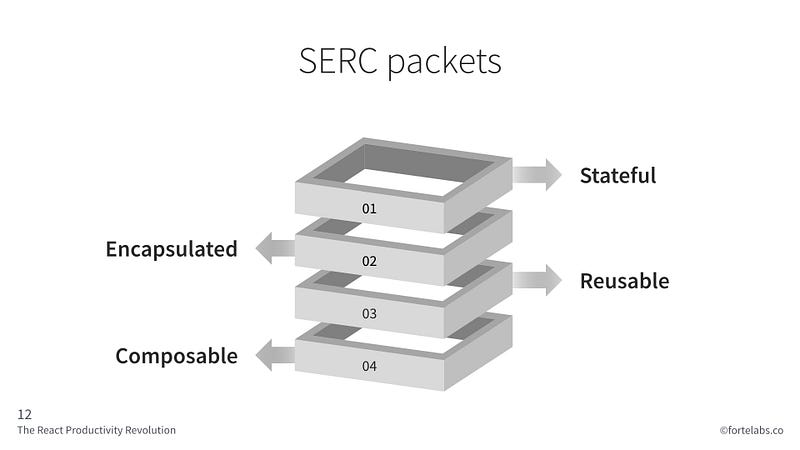
Let’s go through these one at a time.
#1 Stateful
In programming, for a component to be “stateful” means that it “remembers” (or saves) preceding events or user actions.
For our purposes, the equivalent is for us to save all the thinking, content, and research that goes into the work we produce.
There’s a common misconception that our work is made up of tasks. Ask most people to point to their work, and they’ll point to their to do list. But your tasks are not your work. They merely refer to the work that needs to be done. If I destroyed your task list, your work wouldn’t be destroyed. You’d have another to do list generated in no time!
Our work is actually made up of content —not just the code in production, the final report delivered to the client, or the product sitting on store shelves, but all the intermediate information we collect, utilize, generate, and incorporate along the way:
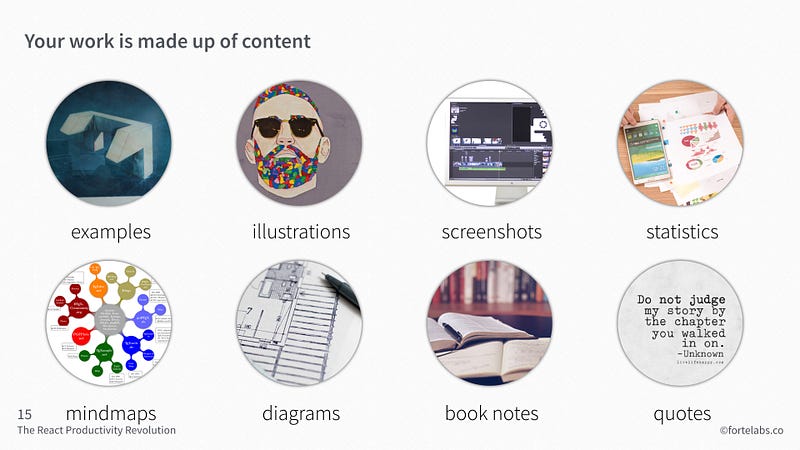
This possibility is intimidating, because this content is stunningly diverse, complex, and ambiguous. It can’t be made into a simple list like tasks. And it’s often difficult to see how it’s valuable or how it could be used outside the context of the current project.
But this is the work of our lives. Think about how much time and effort we put into formulating our tasks, and how little into managing the knowledge gained from performing those tasks.
Step 1 is therefore to:
Step 1: Collect all this content from all the places where it lives, into a centralized location where it can be organized
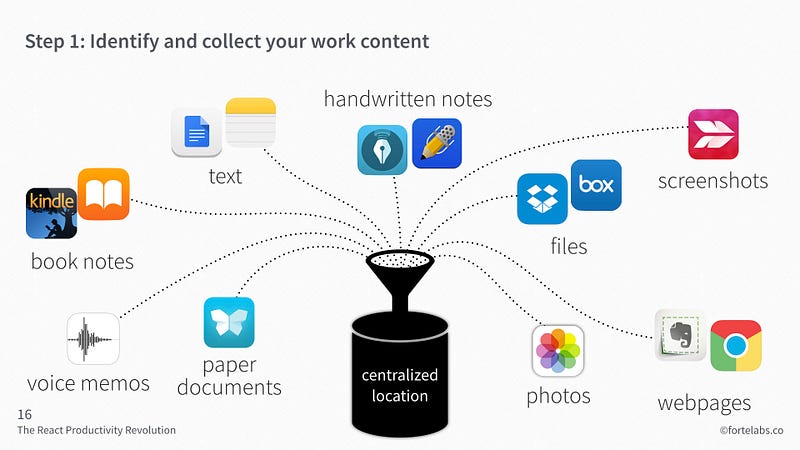
While we have many options for where to collect this content (from cloud storage to code repositories, wikis to message boards, social media networks to Google Docs, visual tools like Trello to mind-mapping apps like Mindnode), there is really only one type of app I can fully recommend: note-taking apps.
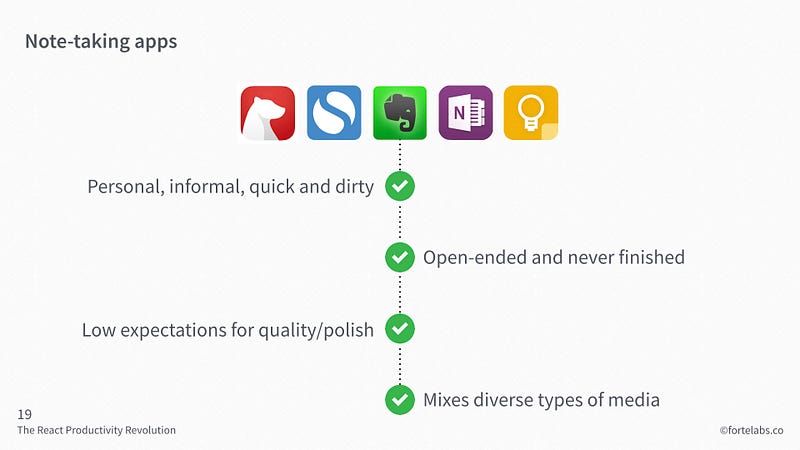
The best paradigm for how to think about “packets of content” is not documents, files, components, or modules, but “notes.”
Notes are:
- Personal, informal, quick and dirty: notes are optimized not for public consumption, but for your own personal use, like a leather notebook you keep in your backpack
- Open-ended and never finished: “taking notes” is a continuous and generative process, in which you can noodle on ideas without an explicit purpose in mind
- Low expectations for quality/polish: notes are low friction, because they can be messy, incomplete, nonsensical or totally random
- Mix diverse types of media: just like a paper notebook might contain drawings and sketches, quotes and ideas, and even a pasted photo or post-it note, notes naturally combine diverse types of media in one place
Although there are many options, including Bear (Mac and iOS), Simplenote (iOS, Android, Mac, Windows, Linux), Microsoft OneNote (iOS, Android, Mac, Windows), and Google Keep (browsers, iOS, Android), the one I use and recommend is Evernote (iOS, Android, Mac, Windows, browsers), with more than 220 million users around the world.
#2 Encapsulated
In software development, encapsulation is a key feature of object-oriented programming (OOP), which makes computer programs out of “objects” that interact with one another.
For our purposes, the implication is that we need to “package up” our work into discrete, self-contained units. The reason should be intuitive: it’s the same reason you package up a hamburger to go — to protect it from the elements, and make it easy to transport.
Once you have your work content collected in one place, the next step is to break it down into discrete packets, which in note-taking apps are known as “notes”:
Step 2: Separate your content into small packets with clean edges (i.e. notes)
How you break it up is up to you, but use common sense:
- all the notes on a book should probably go together, whereas notes from different articles should be separate
- images from a single website should probably go together, while images from different locations should be in separate notes
- your brainstorm ideas on a single project should probably go together, while random ideas you have in the shower should probably be separate
#3 Reusable
In software, you can create modules of code that perform a broadly useful function (like sorting a table or multiplying a number). These modules can then be used again and again at different points in the program, or even in other programs.
For knowledge work, the benefits of reusability should be obvious: you save time and effort by using content you’ve already produced. Think of it this way: if you reuse some research you did in the past for a new project, you’ve retroactively doubled the productivity of that research. It’s produced double the output with the same amount of input.
But reusability doesn’t happen automatically. It requires some effort to make sure the note will be recognizable and understandable at some future date, without too much extra effort. This involves adding “meta-data” to the note, such that it can be organized and tracked, much like routers and switches do for internet packets.

Meta-data can take on a wide variety of forms, but some common ones include:
- Informative titles: describe accurately and succinctly what this note contains
- Thematic tags: include tags that label the note according to common themes
- Concise summary: summarize briefly what this note is about, so your future self will know if it’s worth reading in its entirety
- Comments and annotations: add your own comments, so your future self will know what you thought about this note
- Bolding and highlighting: call out the best or most interesting parts, so your future self won’t have to find them again
- Links and images: include different types of media, which can make future review more engaging and vivid
Thinking through and adding these elements is what I call “designing the note.” You’re not just archiving something you’re never going to see again. You’re putting some thought into how your future self will evaluate and use the note.
Step 3 is:
Step 3: Design notes for easy search and retrieval
Note that this is a continuous process from here on out, not a one-time deal.
There’s a second step to making your notes easily reusable.
Your future self is not going to wade through thousands of old notes hoping to come across something of value. They will likely ask two questions when starting a new project:
- What have I worked on similar to this before?
- What do I know about this topic?
This suggests a simple but powerful organizing scheme, which is step 4:
Step 4: Organize your notes by project and topic

This ensures that you have a minimal amount of structure around the thousands of notes you will be collecting. For the full version of how to do this, check out my members-only, 4-part series on the P.A.R.A. Method. You can learn more about Praxis membership here.
#4 Composable
In software, modules of code can be combined in different configurations. You can “compose” more complex programs by mixing and matching different modules together.
For our purposes, we need to be able to quickly and easily combine our notes into more complex packages. This is the whole point of capturing all this information in the first place.
This starts with the typical ways we have of retrieving saved information:
- searching (for keywords, titles, or terms)
- filtering or sorting (by date or other criteria)
- browsing (perusing notebooks or folders that seem relevant to the task at hand)
But beyond that it depends a lot on what medium you’re working in. This starts to get into the creative process, which can never be fully organized and structured.
Here’s some ideas though:
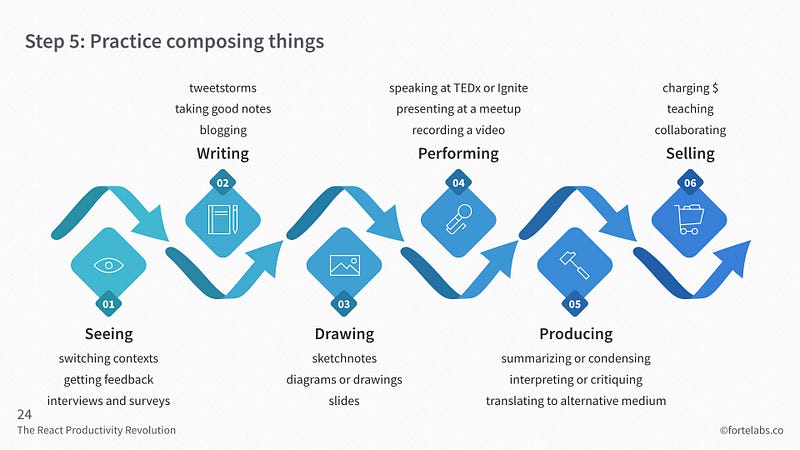
All the above activities represent ways of interacting with or wrestling with information. Instead of passively reading or watching, you want to produce something out of your learning (as in productivity).
Producing a tangible artifact has numerous benefits over mere consumption:
- activates deeper parts of the brain, integrating the senses with your physical movements
- provides an experience for you to remember and put what you learned in context
- gives you something tangible to share and get feedback on from others
- tests your theoretical knowledge against the hard constraints of reality, to see how well you can use it
Making our notes composable can take many forms:
- A photographer keeping a database of their best photos
- A musician keeping a playlist of their favorite songs
- A writer keeping a file of their favorite quotes or turns of phrase
- A salesperson keeping a record of business cards and leads
At some point you may want to use a specialized program to do the above, but until then, manage that content in a simple notebook.
Step 5 is simply to:
Step 5: Practice composing things
Don’t separate learning from making. The more you make, the more incentives you’ll have to improve your personal knowledge management (PKM).
Working with Nodes
Now that we have our work content broken down into small packets, they are well-packaged and labeled for future reuse, and we’ve begun combining them into new projects, we want to expand the capacity of our personal network to handle them.
But what exactly are “nodes” when it comes to the work of a single individual?
I believe that nodes correspond to:
Node: any work session where intelligence is applied
Nodes are your own work sessions over time. When I make a note to self and put it on the fridge, I am transmitting that packet of data through time to my future self. Same thing goes when I summarize an abstract theory I read in a book — I know that most of the details will be quickly lost from my memory, so I’m choosing which ones I want to preserve for future review.
Nodes include other people. When I ask a collaborator to perform an action, whether over the phone, through email or Slack, or in the form of an Asana task, I am creating a neat little packet of work. Once the necessary intelligence has been applied and some value added, they will (hopefully) send back a packet of “processed” content, which I can then integrate into what I’m doing.
Nodes include software programs. When I upload a paragraph of text to Google Translate to get the English translation, I am sending them a packet. When I save a task to my task manager and later find it in a search, a little bit of intelligence was used to remember the note and surface it at the appropriate moment. Working with software generally takes especially careful packaging, because computers can only understand information they were designed to understand.
Nodes include organizations. When I send in my passport to be renewed, I have to follow extremely precise rules and regulations. The U.S. State Department tells you exactly how they like receiving their packets. I expect a certain amount of intelligence will be applied, and the packet I receive back will be of considerably higher value to me.
You can probably see the close parallel to manufacturing. Once we have a network, all the tools of process improvement, network science, and supply chain management become available to us. We can invest in capacity, marketing, or distribution. We can analyze the value stream, measure throughput at different points, and test ideas in research & development.
With ourselves at the nexus of this personal productivity network, we gain immense leverage. Tasks that we don’t want to or can’t perform get routed through the network, picking up intelligence along the way. This can look like tweeting a question to your followers, getting a crowdsourced list of ideas from your newsletter subscribers, or asking a collaborator who you have some social capital with to help you.
It begins to be to your benefit to share as much of the network as possible, because sharing inspires growth. You can give away most of your content for free, because any value created eventually flows to you. You’re immune to competition, because no one can replace you at the center of your network. You can use the network as a platform for the ideas and projects of others, giving them exposure in exchange for yet more value creation.
As the owners and managers of a personal productivity network, we step back from the role of “individual contributor,” working dutifully in our place on the production line, applying our knowledge one unit at a time and getting paid by the hour. We move from being “knowledge workers” to “knowledge managers,” walking the catwalk high above to oversee our factory and think holistically about how all the parts interact.
What we’re really talking about here is building a system. A system of people, software, and organizations working together in an integrated way, with our own personal efforts dedicated increasingly to tweaking and tuning how the system operates. You could call this system your “second brain.”
Such a system has far greater abilities than any individual, including its owner. It intakes your experience and learning and outputs deliverables and projects, capturing and recycling every bit of knowledge produced along the way. It steadily accumulates intellectual capital:
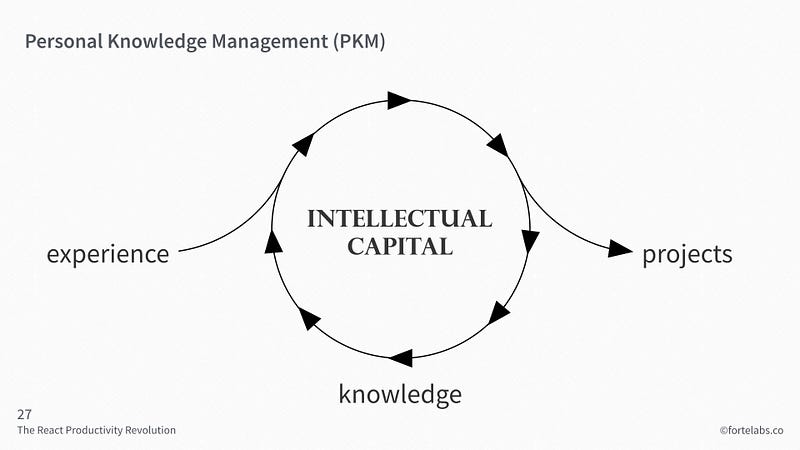
Such a system works day and night, and is measured by value created, not hours worked. Such a system is not limited by the bandwidth of one person’s time, by the limits of one person’s knowledge, or by the level of one person’s capabilities.
The “bandwidth” of such a system is limited only by the intelligence and skill with which you manage, improve, and expand your network beyond the limits of your human self. Once it reaches critical mass, it grows almost without your involvement. After that point, its expansion is limited only by your ability to get out of the way.
Becoming a network is how you increase your productivity 100-fold.
To learn more, check out our online bootcamp on Personal Knowledge Management, Building a Second Brain
Follow us for the latest updates and insights around productivity and Building a Second Brain on Twitter, Facebook, Instagram, LinkedIn, and YouTube. And if you're ready to start building your Second Brain, get the book and learn the proven method to organize your digital life and unlock your creative potential.
- POSTED IN: Building a Second Brain, Note-taking, Organizing, Productivity, Project management, Workflow

